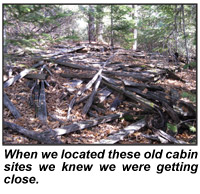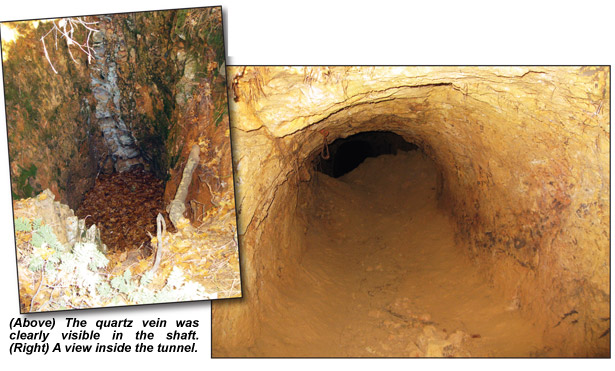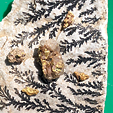All Articles
Prospecting for Hard Rock Gold
March 2010 by Don Robinson
It’s getting harder and harder to find gold these days. Just about everywhere has been hit and in some places hammered hard! We’ve been up and down the rivers and streams, some close by while others required hours of hiking to reach them. We’ve panned, sluiced, dredged, power sluiced and detected. At the present, dredging is shut down in California, causing financial pain to miners, local economies, and the businesses that depend on them.Our alternatives push us to think about things in a different manner. We want to find as much gold as possible, but what new locations do we have? What tools do we have at our disposal and where do we start? As always, research and exploration are essential yet time consuming. We look at all the modern rivers and streams, hydraulic pits, buried river channels exposed, drift tunnels, old dredging fields, and hard rock vein systems too. We read all the books about past mining that we can, looking for clues and alternative locations. The list of new places gets smaller and smaller!
How much gold can we reasonably expect to find when we are temporarily prohibited from using a dredge? Does detecting average better than other methods of prospecting? Will power sluicing in high bench areas yield us more gold? Which way should we go?
I’ve panned and sluiced for years because that’s what I enjoy. I had a four-inch dredge 25 years ago before I moved on into full-scale mining. I’m presently doing underground placer mining, but I still enjoy other types of prospecting.
With the advent of higher gold prices, there are lots of folks out there, some trying to supplement their income and others trying to make a living at it. We all know how tough that is. So what can we expect as an average? I know lots of prospectors, and I’m the president of the Goldhounds, so I see lots of activity. Experience says only a gram per day can be expected without a dredge if you find a reasonable location and work hard at it. A gram is just over 6/10 of one pennyweight. At today’s market, getting an average of 78% from the buyer when gold is selling $1075 per ounce amounts to only $25. I know a few places where we can average one pennyweight per day, which yields $42.00 per day. That’s better.
We know there are some really nice, large finds being made with detectors. I know some of the best detectorists in this part of the country, and they occasionally make some large finds, but how often? Several good friends of mine are outstanding detectorists and they may go days before finding anything. That’s normal. Then they’ll find several pennyweight and more. So what do they average? Chris Gholson is an excellent detectorist who has made some outstanding finds. He recently stated that he and his colleagues recently worked out an average yield per day of only 1.5 grams. That’s just one pennyweight. So what turns out to be the best system?
I think the answer doesn’t lie in the best tool, but where the most gold can be found and how it can be extracted. Then the tool or tools become the next major issue. We should let the gold available determine the best tool, but many allow the tool to dictate the direction. That’s fine. Each person has to decide the course they want to go.
Finally that leads me to this story. With the various rivers and streams hit pretty hard, and hydraulic pits worked a lot as well, what does that leave us? One area I feel that offers some potential is the hard rock vein systems, and particularly the old hard rock mines and their mill sites and old dumps. The old timers were smart, and they prospected more than we’ll likely ever do. They found paying rock and they mined it. Let’s use their knowledge and hard work to our advantage. Some old mill sites are easily accessible while others remain unknown except for a word here and there in some historic mining report or book.
I’m looking for that unknown and remote site that others haven’t found. I want to be the first to uncover some old ore that was dumped because they missed it, and it’s high grade. The stamp mills of the gold rush era were not as good as our present day hard rock mills and the miners didn’t want to waste any time fooling around either. Their assaying methods may have been limited because of their remoteness and sometimes their haste did make waste. Also, new erosion patterns in the past 150 years have created the exposure of some veins that didn’t get worked, and modern tools make that exploration easier today.
So how do we find these old sites and how do we get to them?

For this project I started with geologic maps that showed the vein systems of the area. There’s no use really pursuing prospecting in the area unless there is some kind of faulting that makes sense. I obtained USGS maps of the territory and followed that with research about the old mines along a vein system. Historic information is really critical and will go a long way in helping identify possible locations. Then I checked out the land ownership and mining claim status to make sure I wasn’t tramping on someone’s toes. For this trip all the criteria was a go!
This area is in the Foresthill/Iowa Hill Divide territory of California and follows along the strike of the Melones Fault system. Historic mines popped up all along the way, and I found one that was really intriguing. I knew a bit about the area and that access would require some good hiking. That’s always good from my viewpoint because it likely means not too many people have been to the location. From what our team eventually found, no one has been there in a very long time. This is getting a little ahead of the story though!
Let’s talk more about the research. There wasn’t much to be found in the various mining books, but what was present was exciting. One of the most important items in an old report stated they had a twenty-ton Huntington Mill that was running around 1890. Huntington himself was born in 1836, and invented and patented various pieces of hardrock mining equipment. He had patents on amalgamators, rock crushers, and several types of mills. We just didn’t know which mill was supposed to have been here, but it meant they were crushing rock so that was good thing.
The report also said a tunnel was driven directly into the vein and another tunnel was driven as a crosscut. The vein was also reported to be three to eighteen feet wide! That’s a big vein system. It also mentioned that a shaft had been driven 80 feet deep on the vein and that very high grade ore was extracted. Finally, the report said that considerable stoping had occurred, which meant more high grade ore.
All this information was more than enough to “go for it,” and we prepared ourselves for a rough hike and search.
Getting there required traveling on some small dirt roads, then parking and hiking. We used a GPS and we had a USGS map that showed a tunnel site, but the tunnel wasn’t there. We were reminded that the maps are only as good as those who create them, and this USGS map showed the tunnel a long way from where it actually turned out to be.
There were no trails to speak of, other than some very old and confusing logging road cuts and plenty of bear trails that went through the manzanita. It was a struggle. We criss-crossed the flat and the hillside in deep brush and heavy woods while questioning our sanity.
After several hours we finally found some old home sites that had completely collapsed, and the only items remaining were old boards and metal piping. Finding the old house sites was a good thing, but the old mines and vein systems were still hidden. We knew they had to be nearby. We eventually found an encouraging sign—a quartz outcropping poked out the hillside. It had been pecked on for sure, but not mined. It looked like bull quartz, but it was vein material.

The day was getting late for us. Five hours had gone by and all we had to show for it was some old collapsed buildings. We decided to go higher on the mountainside and to head on out for the day when one of our team spotted what appeared to be some quartz through the trees. Up the hill we went in a small ravine, made a short turn to the right, and there it was. There was a really nice shaft exposing a nice looking quartz vein system, just like the description in the book. Now we were on track for sure!
The day was closing quickly and we had to hike out before it got dark. Still, we had the beginning evidence of what we were looking for, and we rapidly scheduled another day to search this ground some more. We couldn’t quit now, even though we still hadn’t found the old mill site.
Our second day was tougher than the first. More hiking, stumbling, fighting our way through manzanita, and the only new evidence was a large trash dump from perhaps the 1930s located in a ravine. The dump was about 80 feet long and 10 feet wide. It was full of old cans and 1930-type bottles. It was obvious they were here for a long time. Maybe under the dump was another from the late 1890s, but we didn’t have time to dig it out to see.
Where were the tunnels and the mill? It was getting frustrating. As with the previous first day, time was running out. Heading up a narrow ravine we found a small tunnel on the left side into a decomposed vein system! The tunnel was collapsed, but at least it was there. Then further up we found a large tunnel, open partially at the portal, and running back into the hillside. This was a significant tunnel and showed evidence of many years of work. Going out from the tunnel portal was an old washed out, partial road covered with trees. It went into a flat there and surely this was the location of the old mill.
It was now almost dark and our excitement about this find had consumed our time. We had no choice but to hustle out and plan our third trip back.
Now we were getting close to finding something significant, and it was time to plan for the right equipment and tools for our next trip. There was no running water that we could find at the site so panning was out of the question. One tool we really needed was a detector.
I have a detector. I’m not very good at using it, but I will be! One of our team members is really good so we should be covered. Going underground is also part of the plan. Heading underground can be dangerous, but so can stepping off the sidewalk to cross a road. I’m a certified underground miner and have spent 30 years working underground and exploring gold mines, so I know we’ll take every precaution necessary.
We planned on going back the next day, and some of you may already know the rest of the story. We have been waiting four weeks to take the trip! A series of storms hit us hard, and snow came down two feet deep in this area. It’s raining again right now and another storm coming next week is supposed to bring snow down to the 3,500-foot level. It’s early February as I write this and we’re hoping to continue this project next week. Our objective is to explore the old tunnel and check out the stoping inside if possible. We’ll try to locate the old mill site and hopefully find some nice gold-bearing rock! We’re right on the edge so stay tuned, because the rest of this report will be next month! Let’s hope we have some nice gold to show for our efforts!
© ICMJ's Prospecting and Mining Journal, CMJ Inc.
Next Article »« Previous Article
Additional articles that might interest you...
Desert Prospecting Yields More Than Just Gold
June 2020
 This wash was not far from where I once dug a half-ounce nugget, so I knew there was gold in the area.
This wash was not far from where I once dug a half-ounce nugget, so I knew there was gold in the area.
BLM Proposed Rule Making Affects Mining Claims
October 1999
In this proposed rule, BLM is seeking to amend regulations to respond to a recent law that continues to require claimants to pay location and maintenance fees on unpatented mining claims or sites and to provide annual maintenance fee waivers to small miners until September 30, 2001.
In this proposed rule, BLM is seeking to amend regulations to respond to a recent law that continues to require claimants to pay location and maintenance fees on unpatented mining claims or sites and to provide annual maintenance fee waivers to small miners until September 30, 2001.
The Beer That Saved Goldfield
March 1999
The Nevada Historical Society's
"This Was Nevada Series"
The Nevada Historical Society's
"This Was Nevada Series"
Picks & Pans: Detecting Micro-Nuggets
October 2005
Any detector specifically designed to respond to small gold will do. The best ones are the lightest ones with the smallest coils.
Any detector specifically designed to respond to small gold will do. The best ones are the lightest ones with the smallest coils.
Soft Rock Excavation Techniques
December 2022
Mining Stock Quotes and Mineral & Metal Prices
October 2004
Bush Taps Utah Resident for Labor Post
May 2001
President Bush has said he will nominate a Utah mining consultant to become Assistant Secretary of Labor for Mine Safety and Health (MSHA).
President Bush has said he will nominate a Utah mining consultant to become Assistant Secretary of Labor for Mine Safety and Health (MSHA).
Subscription Required:
The Bawl Mill
• Legislative and Regulatory Update
• Utah Proposes Using Eminent Domain Against Federal Government
• Gold in Alaska
• Beach Mining for Gold
• Mining Trade Group Sues Nevada Over Tax Initiative
• Battle Heats Up Over California Suction Dredging
• China Will Put Rio Tinto Employees on Trial
• Highbanking on the Similkameen River
• Melman on Gold & Silver
• Mining Stock Quotes & Mineral and Metal Prices








